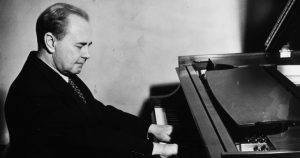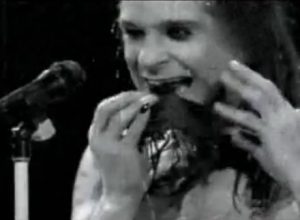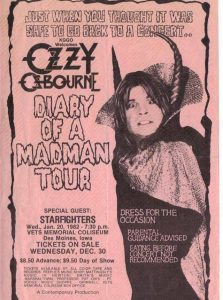
January 20 is indeed an interesting day in music history, particularly notable for anniversaries of births and deaths. Among those born on this day was the outstanding Polish/American pianist Józef Hofmann, born in 1876 (and died in 1967; my grandmother took some lessons with Hofmann at the New York Institute of Musical Art between 1914 and 1916, after which he went on to became the director of the Curtis Institute in Philadelphia, from 1927-1938); also born on this date in 1888 was the 12-string blues guitarist Huddie William Ledbetter (a.k.a. “Leadbelly”; he died in 1949); the Russian/American violinist Mischa Elman was born on January 20, 1891 (and died 1967); the American composer Walter Piston was born on this date in 1894 (he died in 1976 and was featured in my Dr. Bob Prescribes post on March 19, 2019); and Yvonne Loriod, an exceptional French pianist and wife of the composer Olivier Messiaen, was born on this date in 1924 (and died in 2010).

Notable deaths on this date include the Italian conductor Claudio Abbado, who died at the age of 80 in 2014, and the composer, publisher, writer, singer, visual artist, illustrator, patron of young talent, and social activist (wow) Bettina Brentano, the Countess of Arnim, who died on this date in 1859 at the age of 73.
(Elisabeth “Bettina” Catharina Ludovica Magdalena Brentano more than deserves a post of her own. She was a polymath who numbered among her best friends both Beethoven and Goethe. She personally knew and her work was admired by Robert and Clara Schumann, Franz Liszt, and Johannes Brahms among many others. She was the sister of the German writer Clemens Brentano and the wife of the writer Achim von Arnim. Together with her brother Clemens and her husband Achim, she helped gather up and edit the folk poems that were published under the title Des Knaben Wunderhorn (“The Youth’s Magic Horn”), which were set to music by scores of composers (pun intended), most notably Gustav Mahler.

Bettina met Beethoven in May of 1810 when she was 25 years old. An extroverted beauty, she charmed the composer to his cockles – the location of which we will not presently discuss – and for many years had been a leading candidate for the “Immortal Beloved”, the otherwise unnamed woman with whom Beethoven had a torrid love affair in 1812. However, today the identity of the “Immortal Beloved” is generally understood to be Bettina’s sister-in-law Antonie Brentano, who Bettina introduced to Beethoven in 1810.)
Birthdays and death days: causes for, respectively, celebration and grief; days of seminal importance to the individuals involved. But I would point out that birth and death, except in the most tragic cases of the latter, are not issues of willful, conscious choice. Rather, they are natural events over which we have no control. It is not our births (or deaths) that make us who and what we are, that change our lives and the lives of those around us, but rather, the choices we make while we are abroad in this vale of tears.
Choice. What a shockingly loaded word. Really, is there any such thing as free will – choice – or are we (as Dmitri Shostakovich was wont to say) nothing more than marionettes, dancing through our miserable and meaningless lives in a manner directed/predetermined by higher (or lower) forces?
We will presently resist a lengthy and speculative philosophical discussion on whether or not there is truly such a thing as “choice”, just as we will avoid – for now – grappling with other such weighty questions as “Certs: breath mint of candy mint?” or, like, “does anyone really know what time it is”? Rather, we will – for now – consider a single example of “choice”, a choice so radical, so extreme, so memorable and utterly singular that to my twisted mind it renders the births and deaths listed above to relative insignificance.
That choice? On January 20, 1982 – 38 years ago today – when the heavy metal musician Ozzy Osbourne (born 1948), bit the head off a bat during a performance in Des Moines, Iowa.

(When I told my wife – who is a physician – that I would be writing about Ozzy’s little on-stage repast, she said that she hoped, for Maestro Osbourne’s sake, that the bat was not rabid. I immediately expressed greater concern for the bat, given that Osbourn was, at the time, almost certainly rabid.)
He (Osbourne, not the bat) was born on December 3, 1948 in Birmingham, England. He rose to fame in the 1970s as the front man for the heavy metal band Black Sabbath, which billed him as “The Prince of Darkness.” In 1979 he was fired from Black Sabbath because of his drug and alcohol problems. Question: do we all appreciate how stoned and drunk Osbourne had to habitually be in order to be fired by a heavy metal band? The mind reels. The fact that Osbourne is still alive after decades of drug and alcohol super-abuse remains something of a miracle; Black Sabbath guitarist Zakk Wylde has credited Osbourne’s survival to:
“a very special kind of fortitude that’s bigger than King Kong and Godzilla combined. . . seriously, he’s hard as nails, man!”

Following a three-month coke-and-alcohol binge after his firing, the people around Osbourne propped him back up, organized a band, and sent him back out on the road as a single act. He and his band were in the middle of their Diary of a Madman Tour when, on January 20, 1982, they played a concert at the “Des Moines Veterans Memorial Auditorium”, today known as the “Community Choice Credit Union Convention Center.”

The poster for the show that evening warned attendees that “eating before concert is not recommended,” and featured a picture Osbourne wearing horns and a cape beneath the words: “Just when you thought it was safe to go back to a concert.”
It was not uncommon at Osbourne concerts for audience members to throw things on stage: raw meat, snakes, rodents, cockroaches, and other such culinary delights. Having said that, the snakes, rodents, and cockroaches were always toys, made of plastic or rubber.
Well, not the evening of January 20, 1982. That’s when a 17-year-old fan named Mark Neal tossed a dead bat onto the stage, which he had “appropriated” (stolen) from the science department of the local Lincoln High School. In an interview published in 2018, Mark Neal told the Des Moines Register that:
“It [the bat] landed in front of Rudy Sarzo, the bass player. He looked down at it and motioned to Ozzy and, as they say, the rest is history.”
Osbourne, assuming that the bat was a toy, picked it up by its wings and bit off its head. Writing 29 years later in his memoir I Am Ozzy, Osbourne describes what happened next:
“Immediately, though, something felt wrong. Very wrong. For a start, my mouth was instantly full of this warm, gloopy liquid, with the worst aftertaste you could ever imagine, I could feel it staining my teeth and running down my chin. Then the head in my mouth twitched . . . I didn’t just go and eat a fucking bat, did I?”
Looks like you did, big fella.

According to the bat-tosser himself, Mark Neal, the bat had been dead for some time and had already begun to decay, but to this day Osbourne claims that the bat was alive, at least until he chomped down on the poor thing. Dead or alive, Osbourne freaked out, threw what remained of the bat back into the audience, and was hustled off to the Des Moines Medical Center immediately after the show to begin a regimen of rabies shots.
Pam Culver, the nurse supervisor at the hospital on the night of the concert, later told an interviewer:
“For a week, that was probably 50 percent of my job — fielding calls from England and Canada and all over the United States. People wanted to know how much did it cost to do that [meaning the rabies shots], and did it hurt, and how many shots did he have to have, [and] what part of his body did we have to attack.”
Ozzy Osbourne made an interesting choice that evening 38 years ago today, biting the head off that bat. Yes, at that moment, it was yucky-to-the-max. Yes, he had to endure the painful regimen of rabies shots, the after-effects of which caused him to collapse at a concert a couple of weeks later. But more than any other event in his career to that point, it was thanks to the bat that he became a cultural icon with a net worth, today, of some 220 million dollars.
Bat tartare, anyone?
Listen on the Music History Monday Podcast
Podcast: Play in new window
Subscribe: Apple Podcasts | Spotify | Pandora | iHeartRadio | RSS | More
